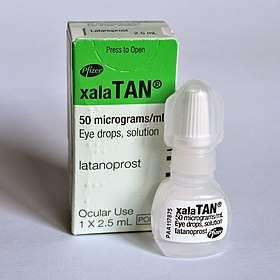Glaucoma medication
The goal of currently available glaucoma therapy is to preserve visual function by lowering intraocular pressure (IOP) below a level that is likely to produce further damage to the nerve. The treatment regimen that achieves the goal of preserving function with the lowest risk, fewest adverse effects, and least disruption of the patient's life, taking into account the cost implications of treatment, should be the approach taken.
| Glaucoma medication | |
|---|---|
 Latanoprost | |
| Specialty | ophthalmology |
The more advanced the glaucomatous process on initial presentation, the lower the target range generally needs to be to prevent further progression. This more aggressive target is meant to minimize the risk of progressive glaucoma damage and vision loss. Once the optic nerve is damaged, it is more likely to incur more damage, and if severe visual loss is present, there is greater impact on the patient from any additional damage that may occur.
An initial reduction in the intraocular pressure of 20% from baseline is suggested. However, reduction of IOP to the target pressure range does not guarantee that progression will not occur. Therefore, the target pressure range needs to be constantly reassessed and changed as dictated by IOP fluctuations, optic nerve changes, and/or visual field progression.
Medical uses
Medications are divided into several groups based on chemical structure and pharmacologic action. Agents in common clinical use include:[1][2]
- Prostaglandin analogs
- Parasympathomimetic (miotic) agents, including cholinergic and anticholinesterase agents
- Carbonic anhydrase inhibitors (oral and topical)
- Adrenergic antagonists (nonselective and selective Beta1-antagonists)
- Alpha 2 agonists
- Hyperosmotic agents
When comparing people with primary open-angle glaucoma and ocular hypertension, medical intraocular pressure lowering treatment slowed down the progression of visual field loss.[3]
Comparison table
| Name | Other names | Mechanism of action | Dosage | IOP decrease | Side effects |
|---|---|---|---|---|---|
| Prostaglandin analogs | |||||
| Latanoprost | Xalatan | Increased USO (uveoscleral outflow ) | Once daily | 25-32% | pigmentation of eyelashes, eyelid skin pigmentation, hyperemia (red eye), flu-like symptoms (joint/muscle pain and headache) |
| Bimatoprost | Lumigan | Increased USO (uveoscleral outflow ) | Once daily | blurred vision, eyelid redness, eye discomfort, permanently darken iris, darken/thicken eyelashes | |
| Travoprost | Travatan | Increased USO (uveoscleral outflow ) | Once daily | blurred vision, eyelid redness, eye discomfort, permanently darken iris, darken/thicken eyelashes | |
| Beta blockers | |||||
| Timolol | Timoptic | Decrease aqueous production | Every 12 hours | 20-30% | bronchospams, bradycardia, depression, impotence |
| Betaxolol | Betoptic | Decrease aqueous production | Every 12 hours | 15-20% | Fewer pulmonary complications due to selective Beta blockage |
| Adrenergic agents | |||||
| Brimonidine | Alphagan | Decrease aqueous production, increase USO | every 8–12 hours | 20-30% | blurring, foreign body sensation, eyelid edema, dryness, headache, fatigue, hypotension, depression, insomnia |
| Miotics | |||||
| Pilocarpine | Isoptocarpine, Pilocar | Increase trabecular outflow | Every 6–12 hours | 15-25% | posterior synechia, keratitis, miosis, brow ache, cataract, myopia, retinal tear, dermatitis, increased salivation |
| Carbonic anhydrase inhibitors | |||||
| Dorzolamide | Trusopt | Decrease aqueous production | Every 8–12 hours | 15-20% | eye irritation, bitter taste |
| Brinzolamide | Azopt | Decrease aqueous production | Every 8–12 hours | 15-20% | eye irritation, bitter taste |
| Acetazolamide | Diamox | Decrease aqueous production | Every 6–12 hours | 15-20% | malaise, depression, weight loss, kidney stones |
Combinations
Fotil is a combination drug consisting of:[4]
- Pilocarpine, a parasympathomimetic
- Timolol, a beta-adrenergic receptor antagonist
References
- Basic and clinical science course (2011–2012). Glaucoma. American Academy of Ophthalmology. ISBN 978-1615251179.
- Myron Yanoff; Jay S. Duker (2009). Ophthalmology (3rd ed.). Mosby Elsevier. ISBN 9780323043328.
- Vass, C.; Hirn, C.; Sycha, T.; Findl, O.; Bauer, P.; Schmetterer, L. (2007-10-17). "Medical interventions for primary open angle glaucoma and ocular hypertension". The Cochrane Database of Systematic Reviews (4): CD003167. doi:10.1002/14651858.CD003167.pub3. ISSN 1469-493X. PMC 6768994. PMID 17943780.
- FASS (drug formulary): Fotil. Retrieved 2015-02-17